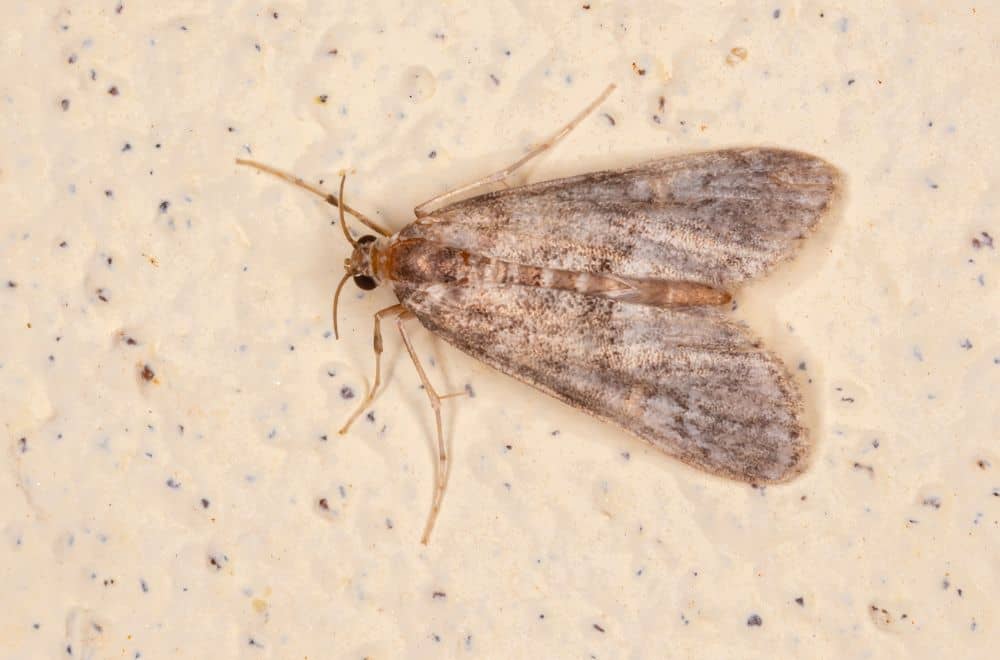Many different pests may turn up in our homes, but few are as unpleasant as an infestation of rice moths and their larvae, which we may discover as a mass of wriggling caterpillar-like worms in our packets of rice, pasta or breakfast cereal.
Such an infestation can also be difficult to deal with, and it will take at least several weeks before you can be sure they’re all gone – so to help you eradicate them from your cupboard or pantry, in this post, we have all the info you need about how to get rid of rice moths.
What are rice moths?
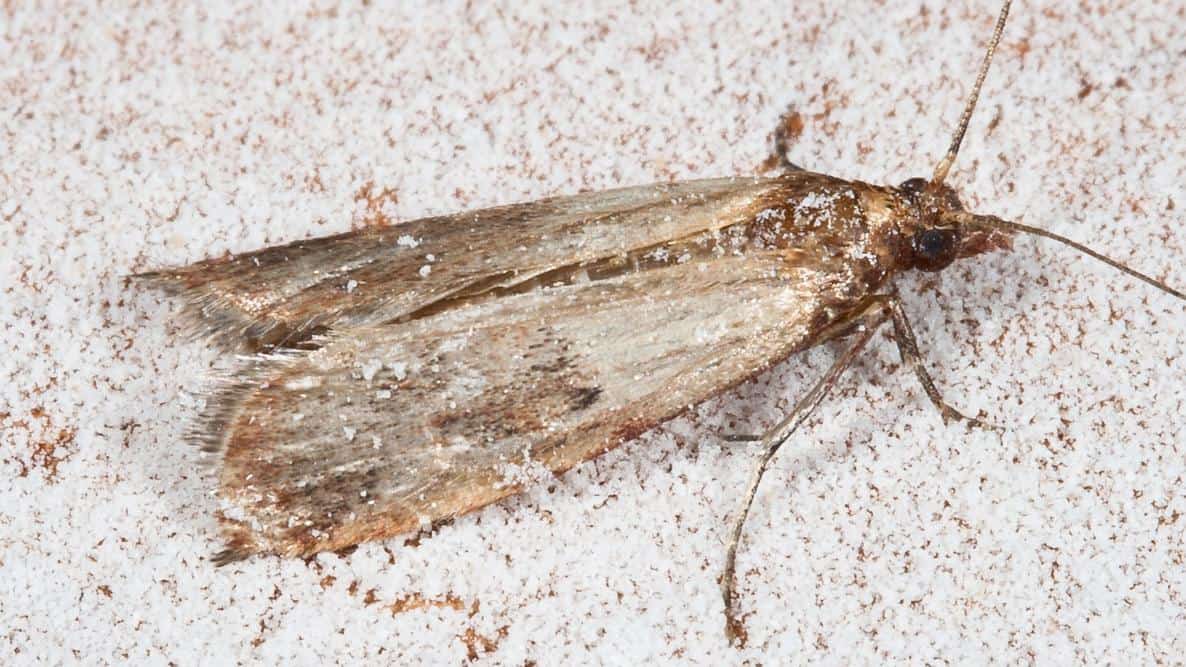
Image Credit: almanac
Before we talk about how to get rid of rice moths, let’s start by saying a few words about what they are so we know exactly what we’re dealing with.
Technically, the pests we call rice moths go by the scientific name Corcyra cephalonica.
They are a small moth species that measures about 0.4 inches in the adult stage and that infests stores of food, consuming rice, grain, cereals, seeds, flour, dried fruit and several other types of food.
They can be found in pantries and store cupboards, and after laying their eggs in places like these, their larvae then emerge to consume whatever food they find there.
However, there are several other species of moth with similar habits, and homeowners may refer to them as things like “pantry moth” or “flour moth” without really knowing which species they belong to.
So while in this post we talk about “rice moths”, we are actually referring not only to Corcyra cephalonica but also to any other similar moth species that might infest your supplies of food.
The lifecycle of rice moths
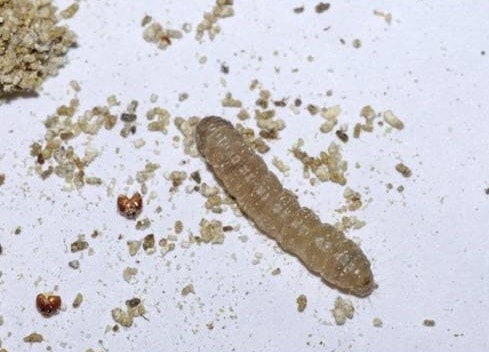
Image Credit: mothidentification
Rice moths start their lives as an egg laid by an adult, usually close to a food source.
After hatching as larvae, they begin to feed, and as they grow, they molt several times. Eventually, when they are ready, they spin themselves into a cocoon, known as “pupating”, and prepare to metamorphose into an adult moth.
When the adult moth emerges from the cocoon, it then looks for a mate, and after mating, the female lays more eggs, beginning the cycle anew.
The problem with this is, the places where we store foods like rice, grains and flour are ideal locations for these moths to lay their eggs, and when they emerge from their eggs, the larvae will quickly set about eating everything they find.
Furthermore, they are quite capable of chewing through plastic or paper food packaging, so even unopened food is not safe.
In such favorable conditions, after the adults emerge, they will quickly lay more eggs, and before you know it, you have a full-blown infestation to deal with.
How do you know if you’ve got an infestation?
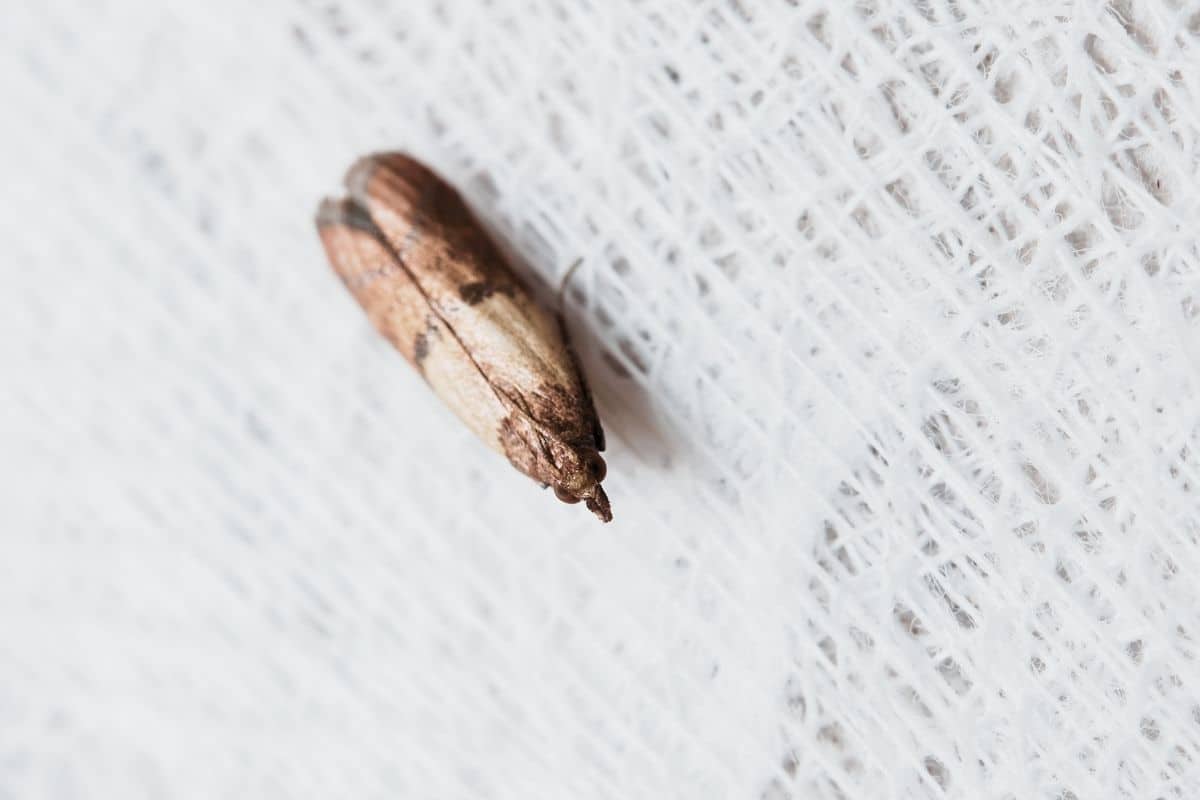
Image Credit: housewifehowtos
Unfortunately, moth eggs or pupae are often brought in with the groceries you buy from a store – infestations don’t usually begin with a single moth flying into your home and laying eggs in your pantry.
This means an infestation can be well underway before you notice it. But what are the tell-tale signs you should look out for?
There are several things that might let you know you have a rice moth problem.
For example, if you notice tiny moths buzzing around where you keep your food, this is a clear indication that you should investigate further.
However, you might also notice small holes in food packaging, which are made by the larvae chewing their way through the plastic or paper to get at whatever is inside.
You may also see webs from the cocoons the larvae spin, along with tiny eggs, egg shells, pupae, fecal pellets or the skins shed by the larvae as they grow.
All of this is pretty gross if you find any of it in your breakfast cereal or packet of rice, but even worse is if you find the wriggling caterpillar-like larvae in the food in your pantry.
In any case, whatever it is that alerts you to the infestation, the key is to act fast – because the longer you leave it, the harder the infestation will be to deal with.
How to get rid of rice moths
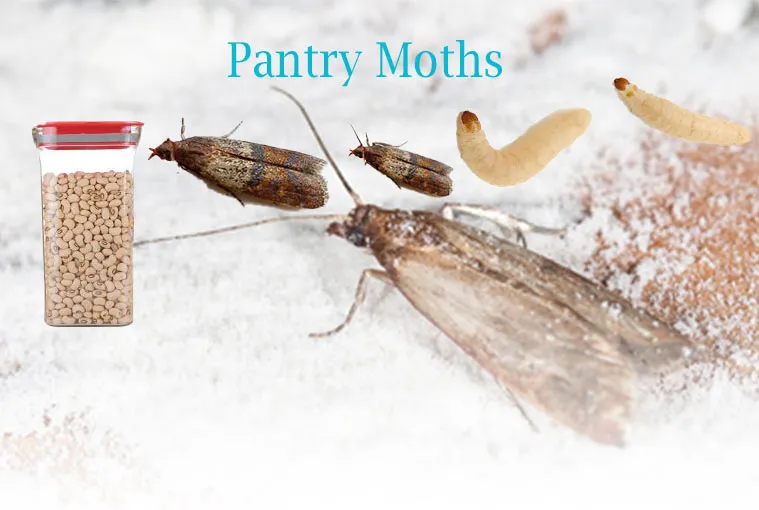
Image Credit: everydaycleaningideas
Here’s what to do if you find evidence of any kind of rice or pantry moths among your bags of stored food.
1. Investigate your pantry carefully
The first thing you need to do is investigate the extent of the infestation, and this means emptying your pantry completely.
If you want to deal with the infestation promptly and effectively, it’s not even worth contemplating taking any shortcuts, so everything needs to come out.
Check every bag and container of food, including all unopened bags and packets. Remember, these bugs can eat through the packaging, so they can still be inside the food, even if it isn’t open.
Also check inside the pantry, looking under all the shelves and in every corner, using a torch if you need to.
This should give you an idea of how serious an infestation you’re facing.
2. Throw out all infected food
Any food that is infected needs to be thrown out, so tie it up in a bag and get rid of it.
Don’t just throw it in the regular trash and wait until it gets taken out a week later because this will give the larvae plenty of time to escape and find somewhere new to hide. Instead, seal it up and dispose of it all immediately.
Feel free to save what you can if you’re sure that certain bags or packets haven’t been affected – but also remember that eggs are very easy to miss, so it might be better to throw everything out whenever there’s any doubt.
Tip: If you’re not sure and you think something can be saved, you can place it in the freezer for a week to kill off any eggs, pupae and larvae that might be in there.
However, this will mean you might inadvertently eat any eggs, pupae or larvae that you’ve missed, so it might just be safer to write everything off and start again.
3. Clean the pantry or cupboard thoroughly with white vinegar
Next, mix up a solution of water and white vinegar with a ratio of 50:50 and use it to thoroughly clean and disinfect the whole pantry.
Make sure you clean underneath shelves, in the gaps behind them, behind the door hinges and everywhere else to make sure that not a single viable egg, pupae or living larvae remains in your pantry.
You might also find it easier if you can remove all the shelves to clean them since this will give you easier access to everything.
4. Wait a couple of weeks before placing food back in your pantry
After cleaning the pantry, don’t refill it immediately. Instead, wait a few weeks to see if any more moths or larvae appear in there.
Giving the bugs a few weeks to advance through their lifecycle will help you spot them, and if you see any evidence that any have remained, you can repeat the whole process of cleaning– and you won’t have to remove all your food again to do it.
Tip: If you have to clean a second time, widen the scope to include the area surrounding the infected pantry or cupboard to make sure you get any eggs, pupae or larvae that might be nearby.
5. Put the food back in your pantry
Finally, after you are sure no moths in any stage of their lifecycle are present, you can put the food back in your pantry or cupboard.
How to prevent them from returning
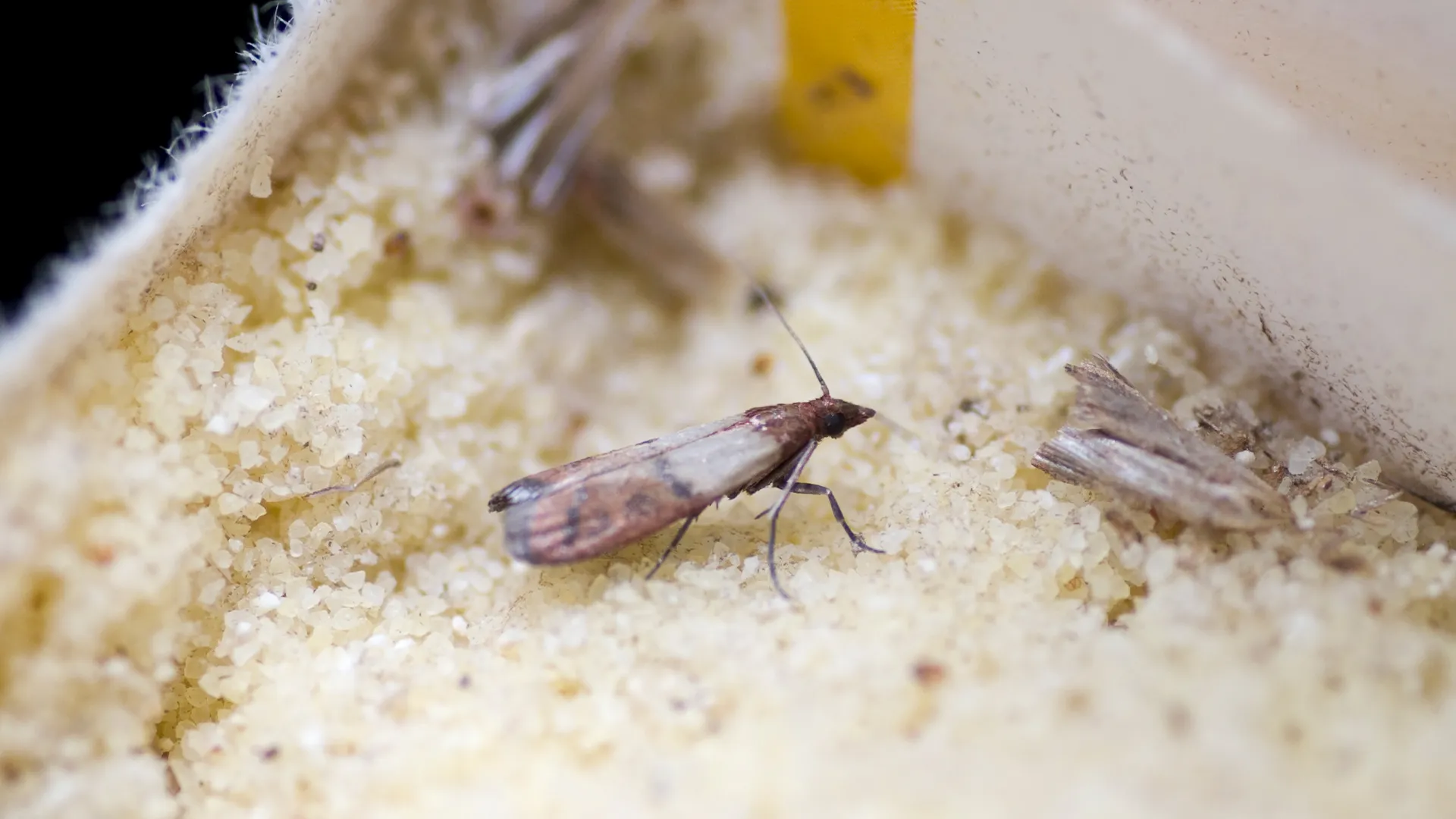
Image Credit: terro
Dealing with a rice moth infestation is a major headache, so you’ll want to make sure they never return.
The key to doing this is to store all of your food in plastic or glass containers that the moths can’t penetrate to ensure that all the food you keep in your pantry or cupboard remains moth-free – but there are some other things you need to do too. Here’s the list:
1. Place food in separate containers after cleaning the pantry
Even while you are still dealing with the infestation and cleaning the infected area, you should place all the food you managed to save in individual containers.
This way, if any moths at any stage managed to survive your cleaning, you will quickly be able to spot them. They will also be contained inside one container and you can dispose of them safely without any risk of the moths infesting any of your other food.
2. Always store food in sealed containers
When the infestation is over and you place all the food back in your pantry, you should always ensure that everything is always kept in sealed containers – for two reasons.
First, this will prevent any moths or larvae from reaching your food supplies to feed or to lay eggs – but second, it will also contain any bugs that manage to infect any of your food so they can’t get to any of the other food stored in the same place.
3. Inspect new food carefully before placing it in your pantry
Disturbingly, it’s more common to bring an infestation home with food you’ve just bought from the store than it is for a moth to simply turn up in your home and start laying eggs.
For this reason, you should always inspect new food carefully before placing it in your pantry with everything else.
In fact, you should develop a habit of checking food over carefully before you even buy it – because, for example, a bag of flour full of holes should never even make it as far as your shopping basket, let alone your home.
4. Place new food in plastic containers
Just as you do with all food that’s already in your pantry, you should place all new food you buy in individual plastic containers.
This will prevent it from being infested by any moths or larvae that are already present, and it will also stop any new bugs infesting the rest of your store cupboard if they have managed to hitch a ride into your home without you detecting them.
5. Check your pantry frequently
Having successfully dealt with an infestation, you should then continue to check your pantry or cupboard frequently, especially in the weeks after an infestation.
If you are careful about storing everything in sealed containers, after the first few weeks or so, you won’t need to do this as often.
Even so, checking regularly and catching an infestation early will make a new infestation easier to deal with, and it might also mean you don’t lose as many packets and bags of food.
Tips for dealing with rice moths
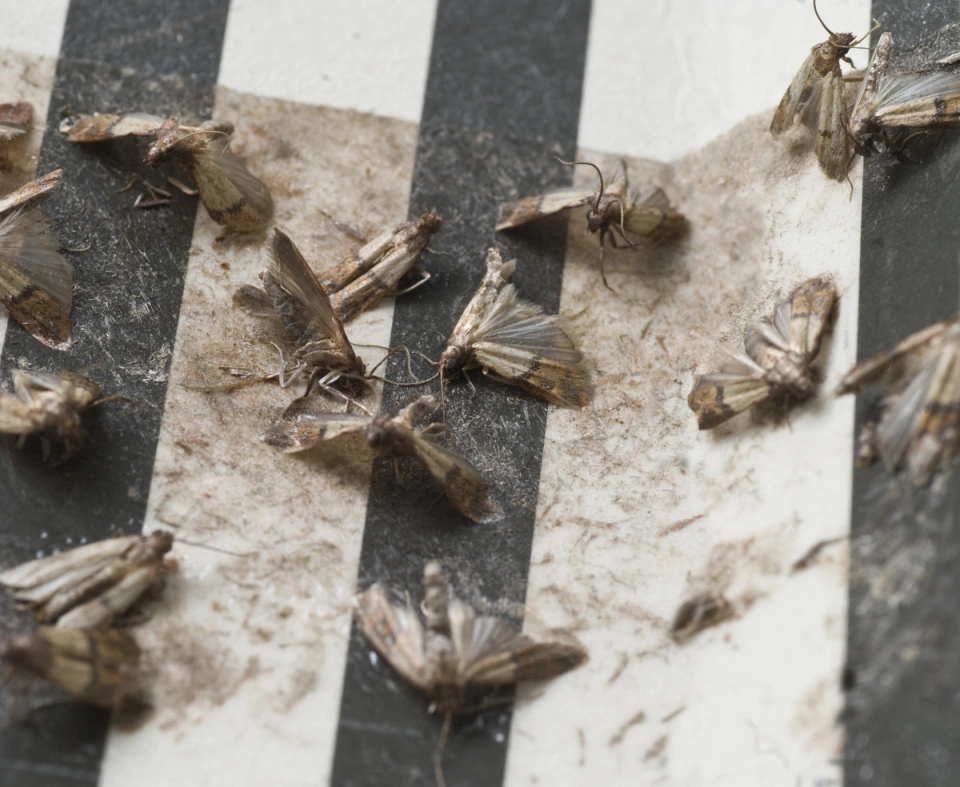
Image Credit: thenewdaily
To finish, here are a couple of other tips for dealing with rice moths.
1. Store pet food in sealed containers
Don’t forget that rice moths can feed on pet food and can breed there too, so to prevent an infestation, store your pet food away from human food in sealed containers.
2. Set moth traps to monitor the situation
As a way of monitoring your pantry or cupboard, you can set moth traps. This isn’t an effective way of controlling or ending an infestation, but it will let you know if moths are present, giving you a kind of early warning system that tells you to take action.
3. Don’t use insecticides near food
You should never use insecticide to kill moths or moth larvae that are eating your food.
This is because these kinds of products are toxic. The moths or larvae may spread the insecticide over human food, and this may poison you – and even if they don’t, it’s a bad idea to use poisonous chemicals near where you keep your food anyway.
Prevention is always better than a cure
Finding a rice moth infestation is pretty disgusting, and getting rid of them can also be hard work – and that’s before you even consider the cost of all the wasted food they infested.
As a result – and as ever – prevention is better than a cure, so as well as learning how to beat a rice moth infestation, hopefully, this post has also helped you understand how to prevent one from starting in the first place.
